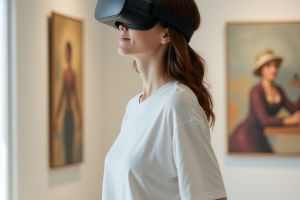Have you ever wondered what it would feel like to step inside a painting or a sculpture? Virtual Reality (VR) has the potential to turn this fantasy into reality.
In recent years, VR technology has made significant strides in the world of art, providing a new, immersive experience that allows viewers to explore art in ways never before possible.
This article explores how VR is transforming the way we interact with and experience art, and how it creates a more engaging and personal encounter with artistic creations.
As artists and creators, we have always sought new ways to engage our audiences. Today, VR technology is enabling a deeper level of engagement, allowing us to break free from the constraints of traditional art galleries. Through virtual worlds, viewers can experience art not just as spectators but as participants, immersed in the very fabric of the artwork itself.
The Rise of Virtual Art
Virtual reality has opened up entirely new avenues for artists. Unlike traditional media, VR allows for the creation of fully immersive environments that viewers can interact with. This opens the door to a completely different way of creating and experiencing art. Rather than simply observing a piece of art on a canvas or in a gallery, VR art can be explored from every angle, offering a truly 3-dimensional, interactive experience.
The key to VR art is its ability to engage all the senses. While traditional art relies mostly on visual and, to a lesser extent, tactile elements, virtual reality brings a whole new level of sensory engagement. Artists can create an environment where sound, movement, and touch are as important as the visual aspects. This multisensory experience helps create a deeper emotional connection with the artwork and draws the viewer in, blurring the lines between the physical and the virtual.
How VR Creates Immersive Experiences
We've all heard of “immersive experiences,” but what does this really mean in the context of VR art? Immersion occurs when a viewer feels as though they have truly entered the world of the artwork. VR uses sophisticated technology to create environments that seem real, with 360-degree visuals, 3D sound, and even the ability to interact with the virtual world. When these elements come together, the viewer can feel like they are not just observing the artwork but living within it.
For example, in a VR art installation, we might step inside a digital painting, where the colors swirl around us and the brushstrokes seem to come to life. Or we might wander through a virtual museum, interacting with sculptures that respond to our touch. These interactions blur the boundary between reality and imagination, allowing us to engage with art in a more personal, direct way than ever before.
The experience can also be tailored to the viewer's actions. As we move through the space, the artwork can change in response to our movements, creating a dynamic and evolving experience that feels unique to each person.
Interactive Features: Viewer as Participant
One of the most exciting aspects of VR art is its interactive nature. Unlike traditional galleries, where the viewer is a passive observer, VR art encourages active participation. We, as viewers, are not simply looking at the artwork; we are part of it. Through the use of motion sensors, hand controllers, or even full-body tracking, VR allows us to engage with the artwork in real-time.
Take, for example, VR art installations that invite viewers to sculpt or paint in a virtual space. We might start with a blank canvas and, using hand gestures or controllers, create a piece of digital art that feels as though it's materializing right in front of us. The artwork responds to our every move, encouraging us to explore, experiment, and express ourselves in ways that are impossible in the traditional art world.
This level of interaction fosters a deeper connection between the viewer and the artwork, allowing for a more personalized and meaningful experience.
The Benefits of Virtual Reality in Art
VR has numerous benefits for both artists and viewers. For artists, VR offers a new platform for expression, allowing them to create in ways that weren't possible before. Digital tools enable them to craft entire worlds, where every detail can be meticulously controlled. Additionally, VR art can be shared globally, reaching audiences far beyond the limitations of a physical gallery.
For viewers, VR art provides an opportunity to experience art in a deeply personal way. Rather than simply admiring a piece from a distance, viewers can explore it at their own pace, discovering new perspectives and layers of meaning. This level of engagement leads to a richer understanding of the work and can make art more accessible to those who may not have the opportunity to visit physical galleries.
The Future of VR Art
As VR technology continues to evolve, so too will the world of virtual art. We can expect even more sophisticated experiences, with improved graphics, more interactive features, and greater integration with other technologies like artificial intelligence (AI) and augmented reality (AR).
In the future, VR art may become a regular part of gallery visits and art exhibitions. Imagine attending a virtual gallery tour from the comfort of your home, or participating in a collaborative VR art project with artists from around the world. The possibilities are endless.
As creators, we must continue to push the boundaries of what is possible, ensuring that the immersive experiences we offer are not only innovative but also meaningful and impactful. With VR, the future of art is limitless, and the audience's role in it is more exciting than ever.
Conclusion: Art Without Boundaries
In conclusion, virtual reality is reshaping the way we experience art. It allows us to move beyond the limitations of physical space and engage with art in a completely new and interactive way. Through VR, art becomes not just something we look at, but something we can step into and interact with. This transformation is opening up a world of possibilities for artists and viewers alike, creating immersive, personal, and dynamic experiences that were once unimaginable.
Are you ready to explore the world of virtual art? Have you experienced VR art yourself? Let us know in the comments below how VR is changing your perception of art and what you think the future holds for immersive artistic experiences!

